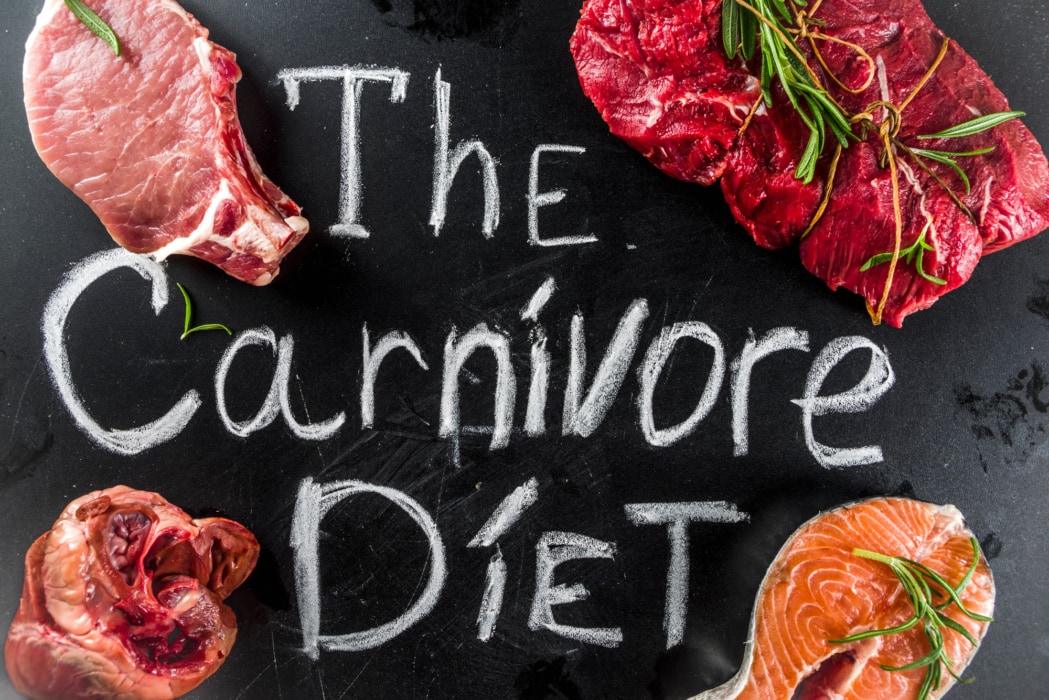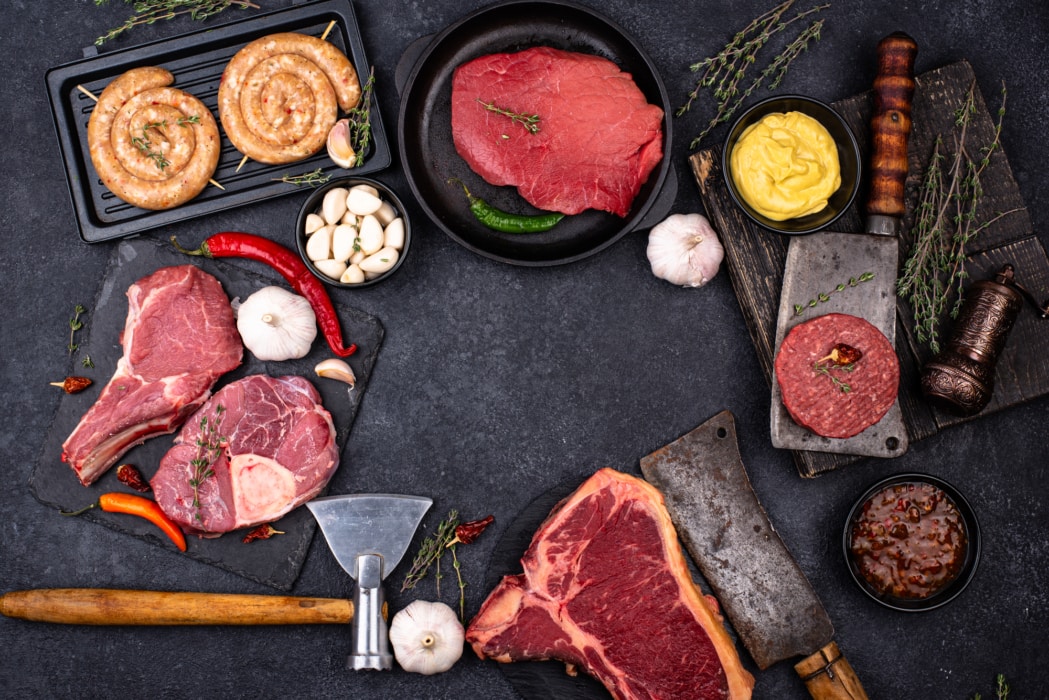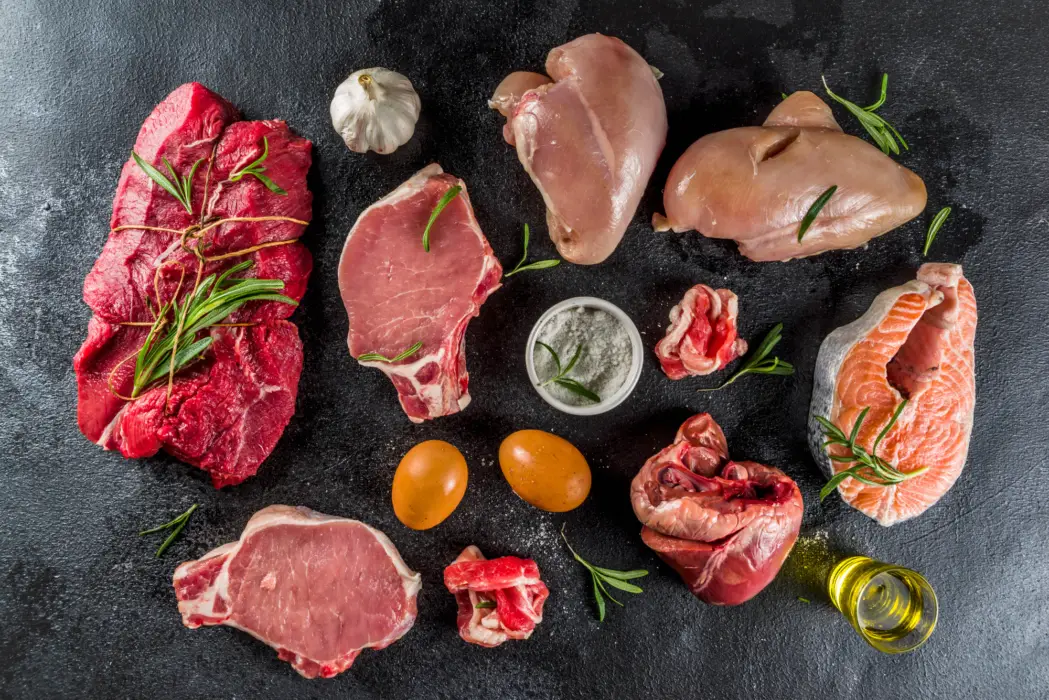Everyone knows about the vegan diet, which completely excludes food of animal origin. However, not everyone knows that there is a diet based on opposite principles. A relatively new nutritional plan called the carnivore diet is now gaining popularity. Probably, if you are familiar with the low carbohydrate diet, you have already heard about its possible zero-carb option called a carnivore diet. What is the carnivore diet?
The carnivore diet can be considered a strict version of the keto diet, as it completely eliminates carbs and plant-based foods. The carnivore or zero carb diet is based on eating animal foods and maintaining the right balance of proteins and healthy fats.

Bacon and eggs for breakfast, juicy steak for lunch, and salmon for dinner. At the same time, all vegetables, cereals, and fruits are prohibited. So what happens if you try this kind of nutrition? How does the carnivore diet work? Is it safe for your health? What benefits can a carnivore diet give your body? Stay tuned for all the details!
What Is the Carnivore Diet?
Carnivore diet, high-protein diet, lion diet, or zero carb – all these are the names of a fairly new and already popular nutritional system that involves a complete transition to a diet of animal origin. Basically, it is the diet of any large carnivore animal. If many other diets suggest including fiber-rich foods in their daily meals, then the carnivore menu contains meat, organ meats, some dairy, animal fats, fish, eggs, poultry, and seafood only. However, this applies only to the stage of adaptation. A pure carnivore diet only allows grass-fed beef and water.
Carnivore FAQ: Main Rules to Follow
Sounds weird, right? But, to be logical, this is how carnivore animals in the wildlife habitat ate. Besides, this is how our ancestors ate. Yes, of course, they were originally engaged in foraging. But the food of plant origin is poorly satiating and is not available all year round. Therefore, the main part of their diet was precisely the meat of various animals, birds, and fish – just like the diet of the largest carnivore animal. Consequently, the ancestors practiced carnivore as a kind of paleo diet, and it was this food chain diet that allowed them not only to survive but also to evolve.
Today, the attitude towards meat in the world is quite skeptical. There is much information about its dangers and even more about the benefits of plant foods and high-carb diets. But if we consider the above facts regarding our prehistoric ancestors, is everything so logical and unambiguous? It’s a tricky question, but we have all the answers to help you decide if this nutrition style is right for you. Let’s find out in detail.

What to Eat on Carnivore Diet?
The main food during the carnivore diet is meat, salt, and water. It would seem that these are all the details, but not everything is so simple. Like any elimination diet, carnivore involves the gradual elimination of some food groups. Therefore, zero carbs diet consists of several stages.
The first stage allows seafood and meat, eggs and fish, poultry and animal fats, dairy foods (low-lactose and fatty), and water, tea and salt, coffee, and electrolytes. At the same time, in the world of research, there are different points of view on whether it is worth leaving dairy foods in the diet at this stage. For example, high-fat dairy food can help your body adapt to a new diet. However, in some people, dairy foods trigger chronic inflammation. In addition, dairy foods fall into two categories. The first contains a small number of carbs – for example, most hard and soft cheeses, Greek yogurt, sour cream, etc. The second category contains a larger amount of carbs, which consists of lactose, which is milk sugar. These are milk, cottage cheese, and other high-lactose foods that you need to avoid on keto and carnivore.
During the second stage, you need to remove all dairy foods and eggs, consuming only fish, meat, poultry, organ meats, seafood, water, and salt. And finally, during the third stage, you can eat only grass-fed beef and water.
But what about hot sauce or lemon juice? You can check our carnivore food FAQ for further information.
Carnivore FAQ: Health & Supplements
Each stage of this high-protein diet lasts a month. Then you can start experiments. First, your body has to be completely cleansed, and then you return food one at a time to the diet, monitoring your body’s reaction. Some people never make the transition from stage one to stage two and experiment with trendy bone broths, organ meats, and natural seasonings. And some immediately refuse not only all food except meat but also any heat treatment. Yes, the most advanced level is raw beef.
What Are the Benefits of the Carnivore Diet?
The benefits of the carnivore diet are various, but often they are individual, such as relieving the symptoms of skin conditions or improving digestion. However, there are a few general benefits that you can get if you follow the carnivore diet properly. Here are the main ones.
Weight Loss
The most obvious advantage of the carnivore diet is quick and fairly comfortable weight loss [1]. Here, the high-protein diet works on the same principle as the keto diet. By cutting out carbs entirely and adding healthy fats, your body begins to break down body fat for energy.
In addition, a sufficient amount of protein releases neurotransmitters that give you vigor and tone your body [2]. Healthy fats affect ghrelin and leptin, the hunger and satiety hormones. As a result, you get improved fat burning while maintaining muscle mass.
Reduced Chronic Inflammation
Dairy foods, eggs, cereals, and bread can cause chronic inflammation. The rate of cardiovascular disease is increasing every year in the United States, and one of the main causes of heart problems is considered to be malnutrition and, as a result, chronic inflammation [3]. High levels of inflammation are seen in people with metabolic disorders, PCOS, migraines, and thyroid problems. The animal diet is suitable for those who experience fatigue and muscle weakness, as well as intestinal problems: dysbacteriosis, bloating, Crohn’s disease, and SIBO [4]. The carnivore diet helps eliminate provocative foods and get rid of allergies, some kinds of chronic disease, and problems with pathogenic flora caused by the diet diversity.
Diversity often triggers asthma, high blood sugar levels, allergies, joint pain, diabetes, and chronic fatigue. The carnivore diet’s beneficial effect lies in the body’s cleansing and antigenic unloading. When no carbs are on your menu, blood sugar does not rise, and body fat does not increase. As a result, the pathogenic flora in the intestine does not grow, and the level of chronic inflammation decreases.
Carnivore FAQ: Foods to Eat and to Avoid
Improving the Quality of Life
Carnivore, being an anti-inflammatory diet, can improve your life in general by influencing many of its factors. For example, zero carb diet improves sleep quality by helping the body recover overnight. It also increases your concentration levels, physical and mental energy, helping to eliminate fatigue.
Reviews indicate that the carnivore diet can increase libido and stamina in men and women, generally having a positive effect on sexual health.
How to Start Carnivore Diet?
You don’t have to count your calorie intake when adapting to a carnivore diet. You just eat natural animal products, excluding cereals, fruits, and vegetables from the diet. If you’re on a low carbohydrate diet, switching to a carnivore meal plan is easier because your fat metabolism is already established, and you’re not addicted to carbs. The difference between keto and carnivore is more protein and even fewer carbs.
Transitioning to such a diet can be difficult for vegans and vegetarians, including a psychological side. Adherents of strict diets can also have a hard time because they need to re-learn how to digest animal fat. However, you can switch to a carnivore diet after any type of diet. It’s just that the speed and adaptation will take a different time.
If you are not used to eating a lot of animal products, then you need to start with easily digestible protein – seafood and fish, and gradually add poultry (like chicken breast) and meat, reducing the amount of plant foods. The carnivore diet does not restrict calories or daily meals. You can eat until you feel full and choose one or four meals a day.
The main thing you need to do is to control the proportions of fats and proteins in your zero carbs diet. Too much protein can harm your health, so ensure you’re eating enough animal fat. The correct proportion of fat to protein should be 1.5-2:1 each meal. It means that you should get 1.5-2 times more calories from fat than from protein.
Carnivore Diet Meal Plan for Beginners
Yes, remember that we are talking about calories from fat and protein, not the weight of your food. 1 gram of fat contains 9 calories, while 1 gram of protein contains 4 calories. At first, you should use the application for counting calories and the correct proportion. Later you will be able to determine the approximate proportion without any tools. As for the weight, the correct ratio is approximately 1:1 fat to protein in grams.

What Are the Side Effects of the Carnivore Diet?
The most obvious disadvantage of the carnivore diet is that there is very little research on this nutritional plan at the moment. While many people have been following the carnivore diet for years and enjoying many benefits, scientific evidence is required to determine the safety of a diet.
Possible Heart Disease Risks
High cholesterol and the risk of heart disease are often associated with a carnivore diet, but this is not entirely true. Yes, the carnivore diet can raise cholesterol if you eat processed meats high in trans fats and sodium. However, a pure carnivore diet can increase good cholesterol, which in turn improves the functioning of the hormonal system and creates proper cell membranes. Therefore, carnivore threatens your cholesterol only if you eat junk food, albeit of animal origin.
Potential Vitamin Deficiency
The carnivore diet can also lead to vitamin deficiencies [5], such as vitamin C, which is predominantly found in plant foods, or B vitamins. Also, low-carb diets lack fiber, which aids digestion. However, the correlative study shows that you can avoid these side effects if you eat a variety of foods on the carnivore diet. Even if you consider only meat without dairy foods and eggs, the whole animal contains all the necessary nutrients. Do not ignore the organ meats, especially the liver and kidneys, and you will get the full range of vitamins you need.
Possible Excess Protein Consumption
There is another danger of the carnivore diet. You’re probably not in ketosis if you’re not eating enough animal fats and only eating proteins. In this case, your body cannot work on fat, and if carbohydrates are excluded, the body does not receive this fuel either. Thus, your body is forced to extract fuel from protein, passing it through the liver and converting it into glucose. This is an extremely energy-consuming process, which also increases the load on the kidneys because they excrete protein breakdown products. Recycling amino acids into fuel is a disadvantageous model for the body, which contradicts the physiological distribution of food components.
Normally, amino acids are the building blocks of your body. With an increased protein intake, the uric acid level increases, which can lead to urolithiasis, gout, and cardiovascular diseases [6]. Therefore, it is important for all meat eaters to observe the proportion of fats and proteins in the carnivore diet.

Even though carnivore is great for humanity as a species, this diet is still contraindicated for some people. It is impossible to switch to carnivore nutrition in acute or exacerbated chronic pancreatitis, chronic renal failure, and serious eating disorders.
The Ultimate Guide to Keto Diet: Foods to Eat and to Avoid
Conclusion
The carnivore diet allows you to quickly and comfortably lose weight, support blood sugar regulation and identify foods that negatively affect your health. It also helps to increase both physical and mental energy and supplies the body with fatty acids and essential amino acids.
The purpose of this diet is to return to clean nutrition and limit the number of foods that provoke chronic inflammation. To do this, you need to go through three stages of a carnivore anti-inflammatory diet based on animal food and then gradually return to different foods and monitor the body’s reaction. However, remember that before you start any diet, especially such a strict one, you should consult your doctor.
Sources:
- Cassady, B. A., Charboneau, N. L., Brys, E. E., Crouse, K. A., Beitz, D. C., & Wilson, T. (2007). Effects of low carbohydrate diets high in red meats or poultry, fish and shellfish on plasma lipids and weight loss. Nutrition & metabolism, 4, 23. https://doi.org/10.1186/1743-7075-4-23
- Omaye, A. T., & Omaye, S. T. (2019). Caveats for the Good and Bad of Dietary Red Meat. Antioxidants (Basel, Switzerland), 8(11), 544. https://doi.org/10.3390/antiox8110544
- Chen, L., Deng, H., Cui, H., Fang, J., Zuo, Z., Deng, J., Li, Y., Wang, X., & Zhao, L. (2017). Inflammatory responses and inflammation-associated diseases in organs. Oncotarget, 9(6), 7204–7218. https://doi.org/10.18632/oncotarget.23208
- Ghoshal, U. C., Shukla, R., & Ghoshal, U. (2017). Small Intestinal Bacterial Overgrowth and Irritable Bowel Syndrome: A Bridge between Functional Organic Dichotomy. Gut and liver, 11(2), 196–208. https://doi.org/10.5009/gnl16126
- O’Hearn A. Can a carnivore diet provide all essential nutrients? Curr Opin Endocrinol Diabetes Obes. 2020 Oct;27(5):312-316. doi: 10.1097/MED.0000000000000576. PMID: 32833688.
- Klurfeld D. M. (2018). What is the role of meat in a healthy diet?. Animal frontiers : the review magazine of animal agriculture, 8(3), 5–10. https://doi.org/10.1093/af/vfy009
